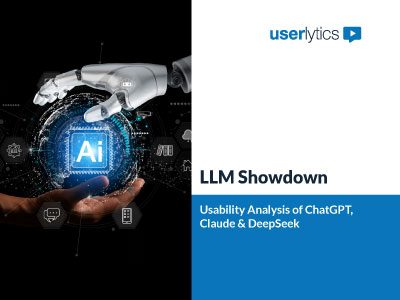Following Google’s announcement about the highly anticipated Gemini 2.0 in early December, the world’s most popular search engine unveiled a plan for its first-ever artificial intelligent (AI) agent. Project Mariner is a research prototype built on Gemini 2.0 that is set to explore the future of human-agent interactions.
Mariner is a Chrome extension that can automate all sorts of web tasks in a user’s browser on their behalf. However, the project, from Google’s DeepMind subsidiary, is still in the early stages of a phased implementation and is only available to a small group of trusted testers.
Before all Chrome users are given access to the helpful AI agent, let’s explore what Google’s Project Mariner is and how it will redefine usability and user testing in the near future.
What Is Google’s Project Mariner?
Google’s Project Mariner is the experimental testing of a Gemini 2.0-powered agent (Mariner) that can understand the contents of a user’s Chrome browser, allowing it to navigate websites much like a human would by taking control of the cursor, clicking buttons, and filling out forms.
Users can leave a written or voice-activated prompt for the AI agent in the chatbot on the right-hand side of their Chrome browser. This prompt will explain what task the user wants the agent to perform on their behalf, including searching for hotels, shopping for household items, and finding recipes.
Mariner can understand everything on your browser screen, including text, code, images, and forms. However, the AI agent will ask for clarification if it does not understand an instruction.
Once Mariner understands the human prompt, the AI agent will show the user a step-by-step explanation of its reasoning process and how it plans to tackle the task. Users will see their cursor move across the web browser as actions are performed on their behalf in real-time.
However, to give users more control over their web actions, the Chrome extension cannot fill out credit card numbers or billing information, accept cookies for users, or sign a terms of service agreement.
For example, if a user prompts Mariner to “create a shopping cart from a grocery store based on this list”, Google’s agent will navigate to a grocery store’s website and add the listed items to a virtual shopping cart.
(Image Source: TechCrunch)
Mariner works by taking screenshots of the user’s browser and sending them to Gemini 2.0 in the cloud for processing. Gemini then sends instructions to the user’s computer on how to navigate the web page. Please note that Google’s agent only works in the user’s active tab, which means you can’t use your browser for other things while the AI agent works in the background.
Mariner not only represents a milestone in AI technology but also a shift in usability and user testing. Millions of businesses have historically relied on Google to send real people to visit and use their websites.
However, if Project Mariner goes well, users will soon become less engaged with the websites they visit, which means humans won’t be required to conduct usability and user testing.
How AI is Redefining Usability and User Testing
Before we explore how Project Mariner will redefine usability and user testing, it’s important to understand how traditional methods are shifting to align with the needs of AI agents.
Both usability and user testing have long been used to collect actionable insights that enable designers and product teams to create a better user experience (UX). However, AI tools like Project Mariner are quickly changing the definition of a ‘user’.
Usability Testing
The usability testing process is in place to evaluate the design and functionality of a website by assessing how easily and effectively users can accomplish tasks. It involves asking real users (rather than designers and developers) to complete a series of specific tasks on the website, usually through unmoderated sessions. The results, success rate, and paths taken by the user to complete the tasks are then analysed so the product team can identify areas for improvement and issues they might have otherwise overlooked.
AI agents like Mariner could emerge as a complementary practice to usability testing as we know it today. Since basic tasks can be completed by the AI agent instead of the users themselves, the usability of a website could become more catered to bots than humans.
User Testing
User testing and user research can be different and may be carried out in additional phases and timelines than what is required for usability testing. It aims to uncover unmet needs and goals, discover unknown pain points and ensure an existing or potentially future product meets user needs and expectations by evaluating product satisfaction, uncovering user pain points, and gathering user feedback. Common user testing methods include surveys, interviews, unmoderated and moderated testing. There are also other quantitative and qualitative user testing methods such as card sorting and tree testing.
Since user testing relies much more heavily on human opinion and satisfaction, AI is unlikely to be able to replicate it anytime soon.
(Image source: Userlytics)
Despite AI being on track to rewrite how usability testing looks for designers, it has not eliminated the need for testing. In fact, it has increased it, since now designers and developers will need to ensure their websites can accommodate both human users and AI Agents with potentially conflicting needs.
Will Project Mariner Change the Future of User Testing?
Traditionally, user experience has been centred around human satisfaction, making human users the core reason for usability and user testing.
Since Google’s Project Mariner is designed to enable AI agents to complete tasks on behalf of users using simple prompts, user engagement is lessened, however, it will take a period of time before user engagement is completely unnecessary, making essential an accommodation of two potentially differing needs.
With AI agents as one of the users of websites and apps, we can expect to see a shift in usability and user testing methods, including the introduction of a dual approach:
- Human-centric testing. Participant recruitment is still required for traditional usability and user testing methods, which should remain in place as it is still crucial to make sure that human users have a smooth and satisfying experience with the product.
- AI-centric testing. During development, simulating AI agent interactions will help assess how well websites assist these bots in completing tasks and evaluate how effectively a site supports their tasks. This might involve using machine learning (ML) models to mimic agent behaviours during product testing phases.
The dual approach for usability and user testing will ensure both human and AI audiences are served effectively.
In addition, the emergence of Project Mariner means website designers and developers must align their strategies with current web design trends to create experiences for both humans and the AI agents acting on their behalf. Having to adapt a website to meet the needs of an AI agent introduces several considerations for product teams, including:
- Machine-readable content. Hypertext Markup Language (HTML) is the basic scripting language web browsers use to render pages on the internet. AI agents rely on a clear, standardised markup to navigate website content and complete tasks effectively.
- Task-oriented design. Complex navigation or unclear processes could hinder the AI agent’s ability to perform multi-step tasks, reducing a site’s effectiveness.
- Personalisation and adaptability. AI agents will learn and adapt based on user behaviours. Designers and developers will need to anticipate possible AI agent behaviours and build websites flexible enough to accommodate them.
In summary, websites must balance easy-to-use interfaces for human users with structures optimized for machine-readability for AI agents.
Are You Ready To Welcome Google’s First-Ever AI Agent?
Project Mariner is still in the early stages of a phased implementation, so website designers and developers have time to learn more about the AI-powered agent and adjust their products accordingly.
However, it is critical for product teams to implement AI-focused techniques early on to ensure their websites stay relevant in an ever-changing and competitive online environment.
Finally, it’s important to note that the implementation of Google’s Project Mariner and other possible AI agents will raise serious ethical questions among users. To gain user trust, websites must clarify how their data is managed and stored when they interact with these agents.
To get ahead and prepare for the impact of Project Mariner, running remote user testing sessions will help gain an understanding of what actions users would consider using AI for and how an interaction could look. Contact Us to get started!
Heather Langley

Heather Langley is a content writer at Solvid with a strong background in marketing. With years of experience helping brands elevate their online presence, she now focuses on writing about the latest digital trends, best practices, and industry insights.




